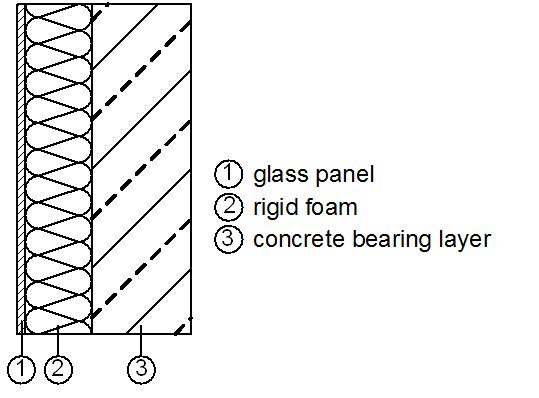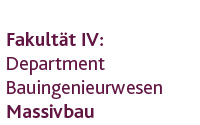Raum: PB-A 108
 +49 271 740-4029
+49 271 740-4029
 metje@bau.uni-siegen.de
metje@bau.uni-siegen.de
Bond in glass-rigid foam-concrete sandwich elements
Research topic
Innovative facade constructions
Funding and project duration
Network project, University of Siegen
Duration: November 2016 until October 2017
Person in charge
Kevin Metje, M.Sc.
Project partner
Chair of Structural Design, Department of Architecture and Urban Development
Project description
In concrete construction, the layout of a classic sandwich element consists of a reinforced concrete or textile reinforced concrete facing layer, an insulation layer and a reinforced concrete bearing layer. The bond between the two concrete layers is provided by anchors made of steel, glass fibre reinforced plastic (GRP) or by spatial textile fabrics.
 In a research project in cooperation with the Chair of Structural Design at the University of Siegen, a new type of sandwich construction was developed in which glass panels as facing layer are connected via the insulation layer to a reinforced concrete bearing layer without any mechanical anchorage. The tensile and shear forces, which result from the dead load of the glass panel and the insulation layer, from wind loads or from restraint, are transferred in the interface layers between the three materials exclusively by adhesion.
In a research project in cooperation with the Chair of Structural Design at the University of Siegen, a new type of sandwich construction was developed in which glass panels as facing layer are connected via the insulation layer to a reinforced concrete bearing layer without any mechanical anchorage. The tensile and shear forces, which result from the dead load of the glass panel and the insulation layer, from wind loads or from restraint, are transferred in the interface layers between the three materials exclusively by adhesion.
120 tensile bond tests and 30 shear tests were carried out at the Chair of Structural Concrete to characterise the bond between various rigid foam panels and cast-on ordinary performance concrete (OPC) as well as ultra-high performance concrete (UHPC). The rigid foam panels consisted of expanded polystyrene (EPS), extruded polystyrene (XPS) and polyurethane (PUR) and had different surface textures.
With OPC, the type of foam and the surface texture had no significant influence on the tensile bond strength of the rigid foam-concrete interface. In contrast, interfaces with UHPC provided higher tensile bond strengths, unless cohesive failure in the insulation material was decisive. In addition, an influence of the surface texture on the test results became evident. The mean tensile bond strength of series with OPC and different rigid foam panels was between 0.135 and 0.156 N/mm² whereas in series with UHPC mean values between 0.193 and 0.251 N/mm² were obtained.
Examination of the interface between rigid foam and concrete by optical microscopy showed a more accurate reproduction of surface details by UHPC, which explains the better micromechanical interlocking between rigid foam and UHPC. The higher content of fines and the more flowable consistency of UHPC may be the reasons for this observation.
In the shear tests on rigid foam-concrete specimens bond behaviour was investigated solely with PUR. The PUR rigid foam panels were milled smoothly either without or with milled grooves. In the experiments, the grooves were aligned in parallel or transversely to the loading direction. With few exceptions, cohesive fractures occurred in the PUR, so that both OPC and UHPC showed only a slight influence of the surface texture of the foam panels on the shear strength of the composite joint. In the different series, the mean shear strength was between 0.155 and 0.177 N/mm² (OPC) and between 0.157 and 0.182 N/mm² (UHPC).
The interface between glass and rigid foam was examined at the Chair of Structural Design.
The production of the glass-rigid foam-concrete sandwich can easily be integrated into the manufacturing process of a plant producing lightweight steel sandwich panels and into the operational procedures of precast concrete plants.
Publications
, 2021. Study on Glass-Rigid Foam Composite for Innovative Concrete Sandwich Elements. Civil Engineering Design. 3(1-2), 3-12. doi:10.1002/cend.202000010
.; ; ., 2020. Bond between concrete and rigid foam in precast concrete sandwich construction. Civil Engineering Design. 2(5-6), 182-192. doi:10.1002/cend.202000011
METJE, K.; LEUTBECHER, T.; WEIMAR, T.; HAMMER, C., 2019. Verbund in Glas-Hartschaum-Beton-Sandwichelementen. Teil 1 - Experimentelle Untersuchungen zum Verbund zwischen Beton und Hartschaum. Bautechnik. 96(10), 731-739. doi:10.1002/bate.201900016
WEIMAR, T.; HAMMER, C.; LEUTBECHER, T.; METJE, K., 2019. Verbund in Glas-Hartschaum-Beton-Sandwichelementen. Teil 2 - Experimentelle Untersuchungen zum Verbund zwischen Glas und Hartschaum. Bautechnik. 96(10), 740-748. doi:10.1002/bate.201900017
LEUTBECHER, T.; WEIMAR, T., 2019. Verbundmittelfreies Beton-Sandwichelement mit Glasvorsatzschale. In: Kongressunterlagen 63. BetonTage: Innovation in Beton. Neu-Ulm, 19.-21. Februar 2019. Betonwerk und Fertigteil-Technik/Concrete Plant and Precast Technology. 85(2), 91.
